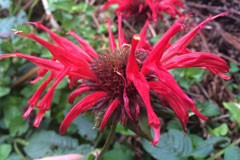
Dahlia 'Redskin'
Reddish purple foliage variety; flowers in mixed colours from orange to red. A welcome addition to the summer border, providing some colourful foliage variation.


The best red monarda; mildew resistant and tough as they come. Like all monarda, these grow best on fertile clay loam or well mulched moisture retentive soil types.
The best red monarda; mildew resistant and tough as they come. Like all monarda, these grow best on fertile clay loam or well mulched moisture retentive soil types.
Data sheet
Reddish purple foliage variety; flowers in mixed colours from orange to red. A welcome addition to the summer border, providing some colourful foliage variation.
Tall growing ornamental grass, with attractive dark green foliage and feathery seedheads in summer.
Larger agave, but still slow growing like most in a temperate climate. Attractive blue tinged erect saw toothed leaves.
Lovely variety with flower spikes in peach and apricot tones, like the colours of old fashioned roses. Clumping habit and long flowering.
A spectacular shrubby species from Chile with greyish felted leaves and contrasting brick red flowers. An unusual and attractive border plant if you have room.
Strawberry coloured blooms with for a sheltered morning sun position or shade, a beautiful variety that doesnt self seed as much as the usual types.
A pleasing break from the usual hot colours, a subtle kniphofia with two-toned pokers in peach and ivory.
Native to Spain, Portugal and Morocco, a spectacular tall grass with attractive seed heads in autumn. Takes a few years to achieve maturity but well worth the wait.
Spreading species from Korea with large white bells speckled pink. Attractive glossy foliage.
A striking cut flower and useful mid summer texture plant between grasses, asters, echinacea, heleniums and sedums. Easy to cultivate, most effective in multiple 25cm spaced group plantings of 3, 5, 7 and upward for maximum impact.
Deep pink hydrangea, flatter lacecap type like 'Tokyo Delight'; note pink varieties are less affected by soil pH than blue varieties.
A soft ochre orange, brighter than 'Terracotta' and softer than 'Paprika'. The yarrows have so many lovely colour variations its hard to know where to stop with these!
One of the best Geranium pratense crosses , flowering all through summer with lovely dark blue flowers reminiscent of Geranium himalayense. Compact shape and long-flowering.
Beautiful grey foliage variety with musk pink flowers in early summer. Trim as lavenders and salvia.
Decorative grass with fluffy 'cats tail' seed heads. Does not seed in our summer dry temperate climates, but can be a strong seeder in warmer humid climates if seed heads not trimmed before dispersal.
A graceful long flowering variety with white centre and light blue petals. Long spurs and more outward facing flower than 'Magpie'.

The best red monarda; mildew resistant and tough as they come. Like all monarda, these grow best on fertile clay loam or well mulched moisture retentive soil types.